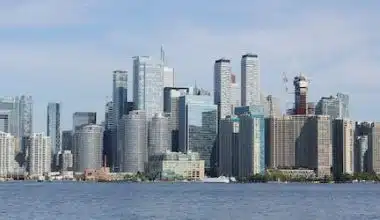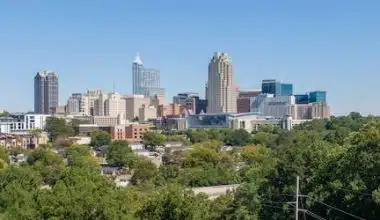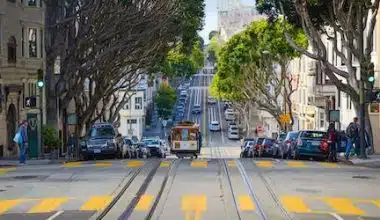Explore the vibrant urban landscapes of South Carolina, where a blend of history and modernity converges in its largest cities, each offering a unique culture, commerce, and community. South Carolina has the most amazing cities you would always love to visit with family or friends, whether for relaxation or fun. These cities have significant economic, cultural, and social impacts and are crucial to the state’s economy, culture, and social landscape. We have outlined these cities with details, so you can choose the ones that suit your interests and budget.
Largest Cities In South Carolina
The largest cities in South Carolina are the ones with the highest population within the state. These cities are significant in terms of population size and play a crucial role in the economic, cultural, and social landscape of South Carolina.
The largest cities in South Carolina are:
#1. Charleston
Charleston is the largest city in South Carolina, with a population estimate of 150,227 as of the 2020 U.S. Census. It is also the oldest city in the state and is known for its rich history and cultural heritage.
#2. Columbia
Columbia is the second-largest city in South Carolina. It serves as the state capital and has a population of approximately 133,451 people.
#3. North Charleston
North Charleston is the third-largest city in South Carolina, with a population of around 115,382 residents.
#4. Mount Pleasant
Mount Pleasant is the fourth-largest city in South Carolina, with a population of about 91,684 people.
#5. Rock Hill
Rock Hill is the fifth-largest city in South Carolina, with a population of approximately 75,048 residents.
#6. Greenville
Greenville is the sixth-largest city in South Carolina, with a population estimate of around 70,635 people.
#7. Summerville
Summerville is the seventh-largest city in South Carolina, with a population of about 54,997 residents.
#8. Sumter
Sumter is the eighth-largest city in South Carolina, with a population estimate of approximately 39,643 people.
#9. Hilton Head Island
Hilton Head Island is the ninth-largest city in South Carolina, with a population of around 39,639 residents.
#10. Florence
Florence is the tenth-largest city in South Carolina, with a population estimate of about 38,885 people.
Features of the Largest Cities in South Carolina
South Carolina is home to several notable cities, each with its unique features and characteristics. While each of the largest cities in South Carolina has its unique characteristics, some collective features can be observed
#1. Historical Significance
Many of the largest cities in South Carolina have a rich historical background and have played significant roles in the state’s history. Charleston, as the oldest city in the state, has a particularly notable historical significance, with its well-preserved architecture and connections to the American Revolution and Civil War.
#2. Cultural Heritage
The largest cities in South Carolina have a rich cultural heritage that draws inspiration from various ethnic groups and historical events. Charleston, for example, is known for its Gullah Geechee culture, which is rooted in the African diaspora and has had a profound impact on the region’s art, music, and cuisine.
#3. Natural Beauty
Many of the largest cities in South Carolina are located near the coast or have access to natural landscapes, such as beaches, rivers, and mountains. Mount Pleasant offers scenic beauty and proximity to the coast, while Greenville is known for its proximity to the Blue Ridge Mountains.
#4. Educational Institutions
Several of the largest cities in South Carolina are home to prestigious universities and colleges, providing educational opportunities and contributing to the intellectual and cultural fabric of the communities. Columbia, as the state capital, is home to the University of South Carolina, while Rock Hill is home to Winthrop University.
#5. Recreational Activities
The largest cities in South Carolina offer a range of recreational activities for residents and visitors. Whether it’s enjoying the beaches in Hilton Head Island, exploring the parks and trails in Greenville, or participating in cultural events and festivals in Summerville, there are ample opportunities for leisure and entertainment.
#6. Economic Growth
Many of the largest cities in South Carolina have experienced significant economic growth and development in recent years. Cities like Greenville have become a hub for business and industry, attracting companies and creating job opportunities.
#7. Parks
Many of the largest cities in South Carolina have a focus on providing green spaces and recreational opportunities for residents and visitors. Charleston boasts 26 city parks, offering areas for relaxation, outdoor activities, and community events. Greenville, known as the “Upstate’s Playground,” offers a variety of parks, trails, and outdoor amenities for residents to enjoy.
#8. African American History and Culture
South Carolina has a rich African-American history, and the largest cities in the state reflect this heritage. Charleston played a significant role in the transatlantic slave trade and has preserved historic sites related to African-American history. The black church has been a vital institution in African-American communities, providing spiritual guidance, social support, and a platform for activism.
#9. Economic and Industrial Centers
Several of the largest cities in South Carolina serve as economic and industrial centers for the state. North Charleston has a rich industrial history, with the Charleston Naval Shipyard and other manufacturing facilities. Greenville has experienced significant economic growth and is known for its business-friendly environment and diverse industries.
#10. Cultural Events and Festivals
The largest cities in South Carolina host a variety of cultural events and festivals throughout the year. Summerville holds the Flowertown Festival, a popular event that attracts visitors from across the region. Charleston is renowned for its Spoleto Festival USA, which showcases performing arts, including music, dance, and theater.
Factors Affecting the Largest Cities in South Carolina
Several factors can influence the development, growth, and characteristics of the largest cities in South Carolina.
Here are the key factors:
#1. Historical Significance and Events
Historical events, such as the Civil War and its aftermath, have had a profound impact on the development and trajectory of South Carolina’s largest cities. The war’s destruction, which included population loss and economic disruption, influenced the cities’ recovery and subsequent growth.
#2. Geographic Location and Climate
The geographic location of the largest cities in South Carolina, including their proximity to the coast, rivers, and mountains, influences their natural beauty, recreational opportunities, and susceptibility to weather-related events. South Carolina’s diverse climate, ranging from humid subtropical to mountainous, affects the lifestyle, industries, and tourism of these cities.
#3. Economic Factors
Economic factors, such as job opportunities, industries, and economic policies, play a significant role in the growth and prosperity of the largest cities. Greenville, for example, has experienced economic growth due to its business-friendly environment and diverse industries.
#4. Cultural Heritage and Diversity
The cultural heritage and diversity of the largest cities in South Carolina contribute to their unique character and attract residents and visitors. African American history and culture, including the Gullah Geechee culture, have had a significant influence on the region.
#5. Infrastructure and Urban Planning
The quality of infrastructure, including transportation systems, housing, and public amenities, can shape the livability and attractiveness of the largest cities. Urban planning and development policies impact the layout, design, and functionality of these cities, including the availability of parks, green spaces, and public facilities.
#6. Population Growth and Demographics
Population growth, demographic trends, and migration patterns influence the size, diversity, and social dynamics of the largest cities. The “New Great Migration,” which has seen Black Americans returning to the South, has contributed to the demographic makeup of these cities.
#7. Wages and Employment
Wages and employment opportunities can impact the economic well-being and quality of life in the largest cities. Factors such as industry trends, job availability, and educational attainment can influence wage levels and employment prospects.
#8. Storm Surge and Natural Disasters
Coastal cities in South Carolina are susceptible to storm surge, which is an abnormal rise of water generated by a storm. Storm surge, combined with high tides, can cause extreme flooding and impact coastal areas. The vulnerability to natural disasters and the ability to mitigate their effects can affect the resilience and development of these cities.
#9. Health Disparities
Health disparities, including differences in health outcomes and access to healthcare, can impact the well-being of residents in the largest cities. Factors such as race, ethnicity, socioeconomic status, and geographic location can contribute to health disparities.
#10. Historical Legacy and Cultural Preservation
The historical legacy and efforts to preserve cultural heritage can shape the identity and development of the largest cities. South Carolina’s history, including the impact of the Civil War and the preservation of historic sites, influences the cultural fabric of these cities.
Attractions In The Largest Cities In South Carolina
South Carolina is home to several vibrant cities that offer a range of tourist attractions. Here are some of the attractions in the largest cities in South Carolina:
#1. Riverbanks Zoo and Garden
This popular attraction features a zoo with a variety of animals and a botanical garden with beautiful landscapes. It offers educational programs and interactive exhibits for visitors of all ages.
#2. Congaree National Park
Located just outside of Columbia, Congaree National Park is a natural wonder with its old-growth forest, diverse wildlife, and scenic hiking trails. It offers opportunities for camping, canoeing, and birdwatching.
#3. Falls Park on the Reedy
This picturesque park is located in the heart of downtown Greenville and features a stunning waterfall, walking trails, gardens, and public art installations. It’s a great place to relax and enjoy the natural beauty of the city.
#4. Broadway at the Beach
This entertainment complex features a wide range of attractions, including shopping outlets, restaurants, theaters, and nightlife options. It’s a popular destination for families and offers something for everyone.
#5. The Peace Center
This performing arts center hosts a range of cultural events, including Broadway shows, concerts, and dance performances. It’s a must-visit for those interested in the arts.
#6. Myrtle Beach Boardwalk
The Myrtle Beach Boardwalk stretches along the oceanfront and offers a lively atmosphere with shops, restaurants, and entertainment options. Visitors can enjoy the beach, amusement rides, and live music.
#7. Greenville Zoo
The Greenville Zoo is home to a wide variety of animals from around the world. Visitors can observe and learn about different species while enjoying interactive exhibits and educational programs.
#8. Ripley’s Aquarium
Located at Broadway at the Beach, Ripley’s Aquarium is home to a variety of marine life, including sharks, stingrays, and colorful fish. Visitors can explore interactive exhibits and even dive with the sharks.
#9. South Carolina State House
The State House is an architectural marvel and serves as the seat of the state government. Visitors can take guided tours to learn about the history and significance of this iconic building.
#10. Mount Pleasant Memorial Waterfront Park
This park offers stunning views of the Charleston Harbor and the Ravenel Bridge. It features a fishing pier, walking paths, picnic areas, and a playground.
Is South Carolina Safe To Live In?
South Carolina has a mixed safety record, with some cities ranking among the safest in the state. However, the overall crime rates in South Carolina are relatively high compared to the national average. Factors such as violent crime rates, property crime rates, and personal safety perceptions can influence the safety of living in the state. Safety can vary between different cities and neighborhoods. Personal protection measures are commonly used by South Carolina residents.
Is Charleston The Capital Of SC?
No, Charleston is not the capital of South Carolina. The capital of South Carolina is Columbia. Charleston was the first capital of South Carolina until 1786 when the state capital was moved to Columbia, which is a more geographically centralized location.
Which State Is Columbia The Capital?
Columbia is the capital of South Carolina. It became the state capital in 1786 due to its central location within the state. The State Legislature first met in Columbia in 1790, and the city was officially incorporated as a village in 1805 and as a city in 1854.
Which Is The Biggest City In SC?
The largest city in South Carolina is Charleston. The official website of Charleston and population data from the U.S. Census state that Charleston has a population of around 150,000 residents as of the 2020 census. It is worth noting that population numbers may vary slightly depending on the source and the specific year of the data.
How Many Large Cities Does Sc Have?
South Carolina has several large cities, including Charleston, Columbia, North Charleston, Mount Pleasant, Rock Hill, and Greenville. With a population of about 153,672, Charleston is the biggest city in South Carolina, and Columbia is the second-largest with a population of about 139,698. Other sizable cities in the state include North Charleston, Mount Pleasant, Rock Hill, and Greenville, each with its own population size.
Which Carolina State Is Bigger South or North?
North Carolina is bigger than South Carolina in terms of land area. North Carolina is the 28th largest state in the United States, while South Carolina is smaller in comparison. However, population size and economic factors can also contribute to the overall significance and influence of a state.
Conclusion
South Carolina’s largest cities are notable for their historical significance and also showcase the state’s rich African-American history and culture. Factors affecting the development and growth of South Carolina’s largest cities include historical events, geographical location and climate, economic factors, cultural heritage and diversity, infrastructure and urban planning, and population growth and demographics. Historical events, geographical location, economic factors, cultural heritage, and demographic trends shape the cities’ unique character and attract residents and visitors.
- THE LARGEST CITIES IN NORTH CAROLINA
- BEST 10 HOTELS IN CHARLESTON IN 2024
- LARGEST CITIES IN SPAIN
- HOW MANY COUNTRIES ARE THERE IN THE WORLD: Detailed List
- BEST COLUMBIA RIVER CRUISES DESTINATION & ITINERARIES IN 2023-2024






